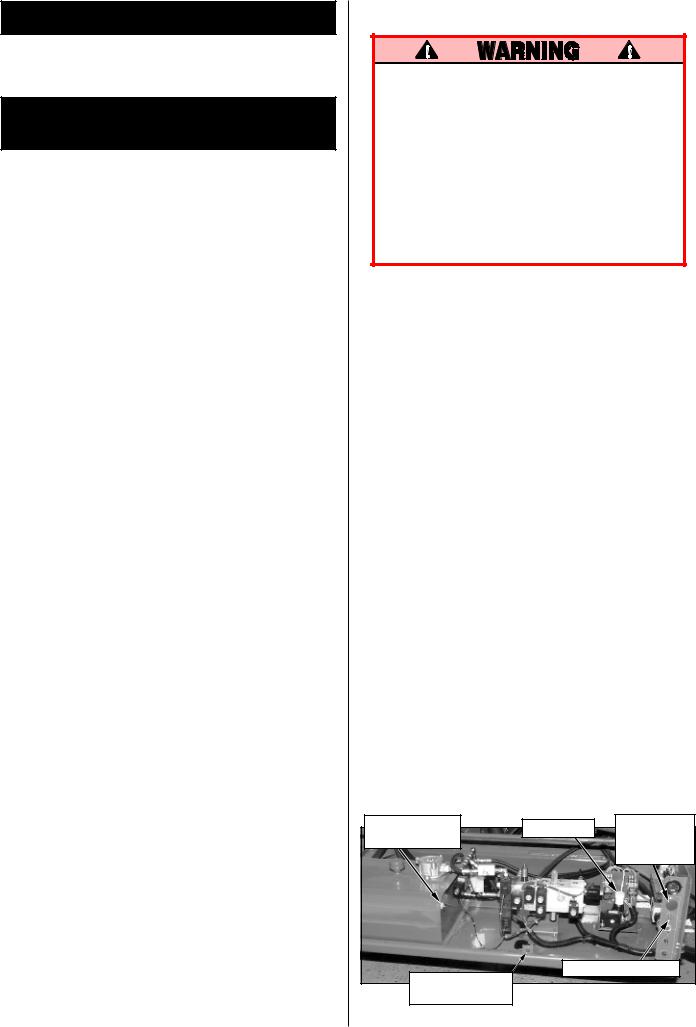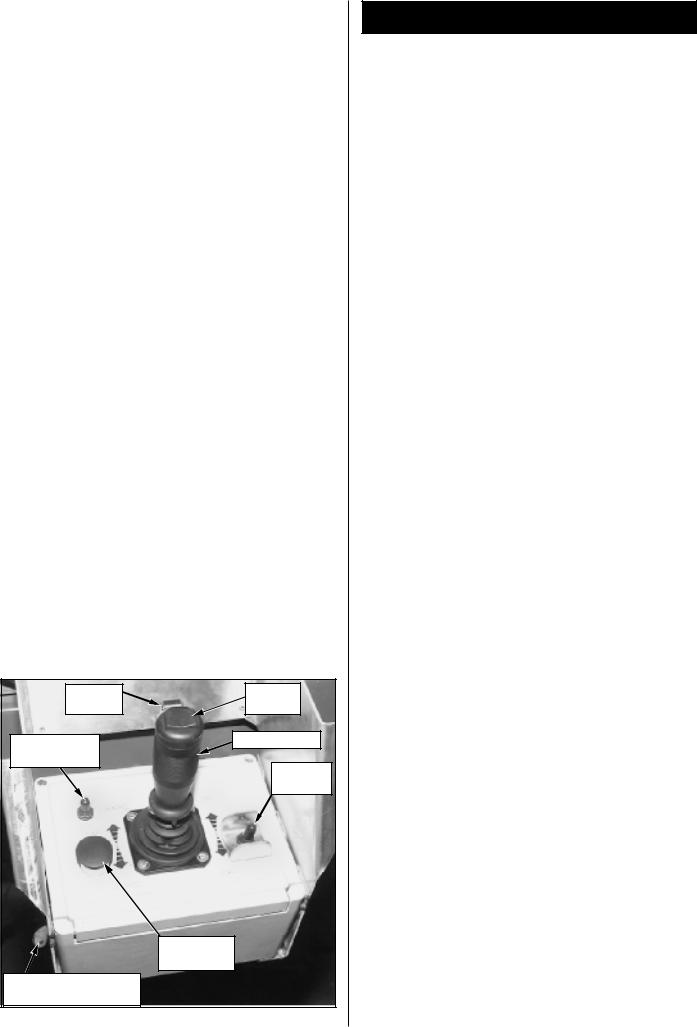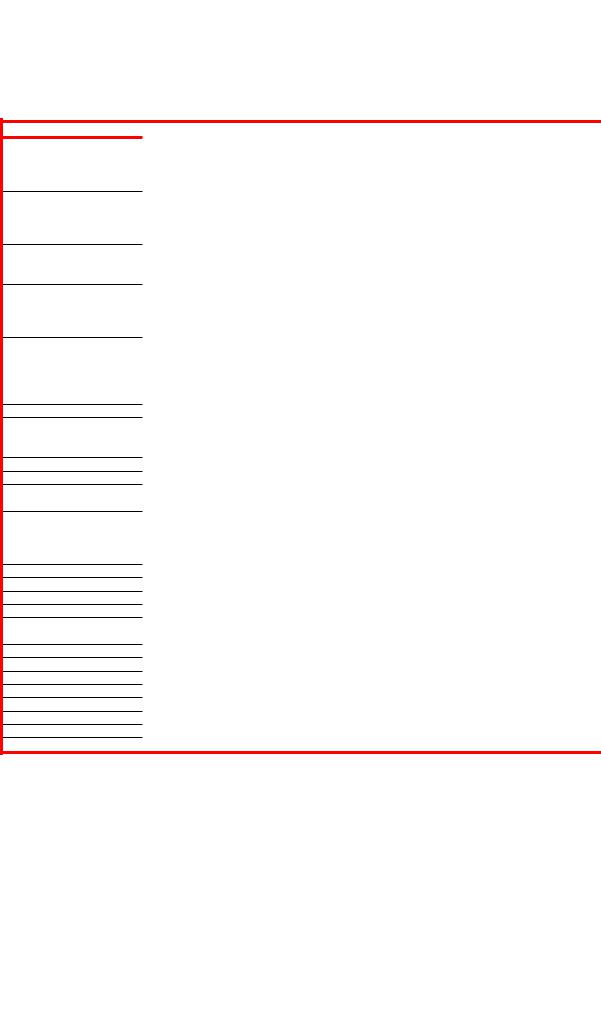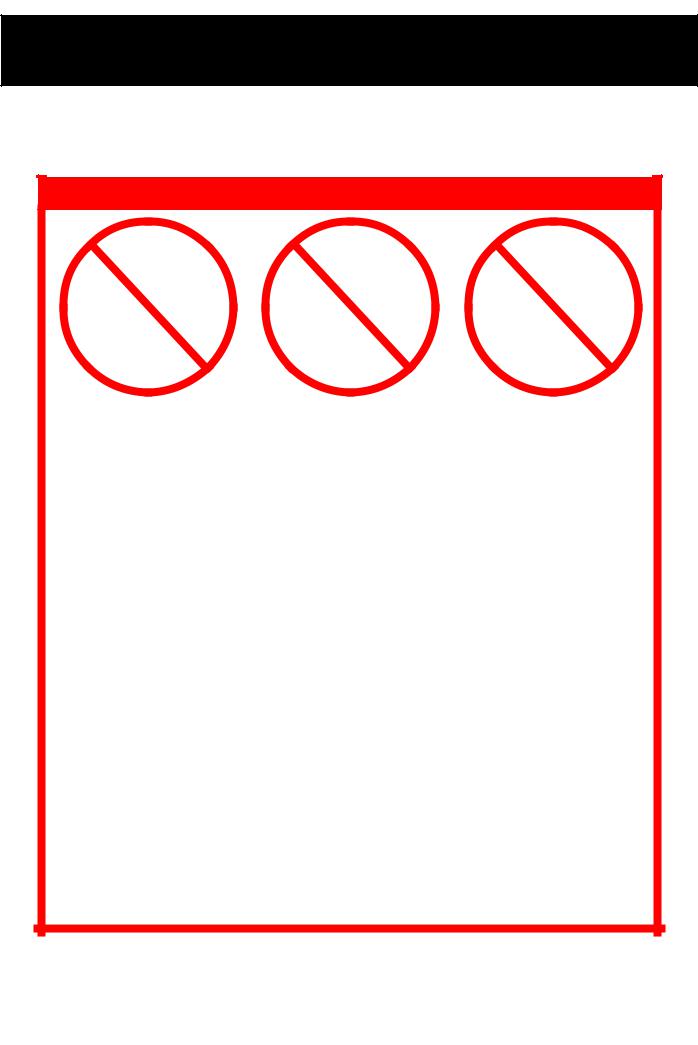Snorkel SL30RT User Manual [en, de, es, fr]

Operator Manual
Manuel de l’utilisateur
Betriebsanleitung
Manual del Operador
SL26/30RT
SERIAL NO. 9600 to Current
WARNING
All personnel shall carefully read, understand and follow all safety rules, and operating instructions before performing maintenance on or operating any UpRight aerial work platform.
Refer to page 3 for the english language version of this Operator Manual.
AVERTISSEMENT
Tout le personnel doit lire attentivement et respecter toutes les consignes de sécurité avant d’entretenir ou d’utiliser une plate-forme de travail aérien UpRight.
Réferez-vous à la page 11 pour la version en français de ce manuel de l’utilisateur.
WARNUNG
Alle Bediener müssen die Sicherheitsregelungen und die Betriebsanweisungen gründlich durchlesen, verstehen und befolgen, bevor sie Wartungsarbeiten an irgendeiner UpRight Scheren-Hubbühne vornehmen oder selbige benutzen.
Siehe Seite 19 zwecks der deutschsprachigen Ausgabe dieser Betriebsanleitung.
ADVERTENCIA
Todo el personal debe leer atentamente, entender y respetar todas las reglas de seguridad y las instrucciones de operación antes de efectuar trabajos de mantenimiento o
manejar cualquier plataforma aérea de trabajo UpRight.
Referirse a la página 27 para la versión en español de este manual del operador.
1

Notes:
2

English Language Section
SAFETY RULES
NEVER operate the machine within ten feet of power lines.
THIS MACHINE IS NOT INSULATED.
NEVER elevate the platform or drive the machine while elevated unless the machine is on a firm level surface.
NEVER sit, stand or climb on guardrail or midrail.
NEVER operate the machine when wind speed is greater than 12.5 m/s (28 mph). NEVER excede the maximum lateral force of 400 N (90 lbs.).
NEVER operate the machine without first surveying the work area for surface hazards such as holes, drop-offs, bumps and debris before operating machine.
NEVER operate the machine if all guardrails are not properly in place and secured with all fasteners properly torqued.
SECURE gate across entrance after mounting platform. NEVER use ladders or scaffolding on the platform. NEVER attach overhanging loads or increase platform size.
LOOK up, down and around for overhead obstructions and electrical conductors. DISTRIBUTE all loads evenly on the platform. See the back cover for maximum platform load.
NEVER usedamagedequipment.(ContactUpRightforinstructions,seephonenumberonbackcover.) NEVER change operating or safety systems.
INSPECT the machine thoroughly for cracked welds, loose hardware, hydraulic leaks, damaged control cable, loose wire connections and wheel bolts.
NEVER climb down elevating assembly with the platform elevated.
NEVER perform service on machine while platform is elevated without blocking elevating assembly.
NEVER recharge batteries near sparks or open flame; batteries that are being charged emit highly explosive hydrogen gas.
AFTER USE secure the work platform against unauthorized use by turning key switch off and removing key.
NEVER replace any component or part with anything other than original UpRight replacement parts without the manufacturer's consent.
3

Introduction
This manual covers SL26/30 Rough Terrain Work Platforms. This manual must be stored on the machine at all times.
Pre-Operation and Safety
Inspection
Read, understand and follow all safety rules and operating instructions and then perform the following steps each day before use.
1.Remove module covers and inspect for damage, oil leaks or missing parts.
2.Check the level of the hydraulic oil with the platform fully lowered. Oil should be visible in the sight gauge. Add hydraulic oil, if necessary (see Specifications, back cover).
3.Check that the fluid level in the battery is correct (see Battery Maintenance, page 8).
4.Carefully inspect the entire work platform for damage such as cracked welds or structural members, loose or missing parts, oil leaks, damaged cables or hoses, loose connections and tyre damage.
5.Check that all guardrails are securely in place with all fasteners properly torqued.
6.Pull out on the Chassis Emergency Stop Button to turn the switch ON.
Engine Inspection
1.Check fuel supply.
2.Check engine oil level with dipstick.
3.While the engine is cool check the radiator coolant level. DO NOT check coolant when the engine or radiator is hot.
System Function Inspection
STAND CLEAR of the work platform while performing the following checks.
Before operating the work platform survey the work area for surface hazards such as holes, drop-offs, bumps and debris.
Check in ALL directions, including above the work platform, for obstructions and electrical conductors.
Protect control console cable from possible damage while performing checks.
1.Unhook Controller from front guardrail. Firmly grasp Controller hanger in such a manner that the Interlock Lever can be depressed, while performing the following checks from the ground.
2.Pull Controller Emergency Stop Button out to ON position.
3.Turn Controller Key Switch fully clockwise to start the engine, releasing the key once the engine starts.
Note: If the engine is cold, turn the key fully counterclockwise and hold for 6 seconds to engage the glow plugs.
4.Place Drive/Lift Switch in DRIVE position.
5.With the Speed Range Switch first in HIGH TORQUE and then in HIGH SPEED actuate the Interlock Lever and slowly push the Control Lever to FORWARD then REVERSE positions to check for speed and directional control. The farther you push or pull the Control Lever from centre the faster the machine will travel.
6.Push Steering Switch RIGHT then LEFT to check for steering control.
7.Rehook Controller on front guardrail.
Hydraulic Tank |
Tilt Sensor |
Chassis |
Sight Gauge |
|
Emergency |
|
|
Stop Buttton |
Emergency |
Chassis Lift Switch |
|
|
|
|
Lowering Switch |
|
|
Figure 1: Control Module, Chassis Left Side
4

8.Push Chassis Lift Switch to UP position and elevate platform while pushing the Tilt Sensor off of level. The platform should only elevate about .3 m (1 ft.) and the Tilt Alarm should sound. If the platform continues to elevate and/ or there is no alarm STOP and remove the machine from service until repaired.
9.Release the Tilt Sensor and fully elevate platform.
10.Visually inspect the elevating assembly, lift cylinder, cables and hoses for damage or erratic operation. Check for missing or loose parts.
11.Lower the platform partially by pushing Chassis Lift Switch to DOWN, and check operation of the audible lowering alarm.
12.Push down on the Chassis Emergency Lowering Switch to check for proper operation. Once the platform is fully lowered, release the switch.
13.With only one Emergency Stop Button pushed down, in the OFF position, operate a control to verify that the Emergency Stop Switch is functioning. Repeat the test with only the other Emergency Stop Switch OFF. If any function operates with either Emergency Stop Switch in the OFF position STOP and remove the machine from service until it is repaired.
14.Close and secure module covers.
15.Turn the Controller Key Switch counterclockwise to OFF.
Interlock |
Steering |
Lever |
Switch |
Speed Range |
Control Lever |
|
|
Switch |
Drive/Lift |
|
|
|
Switch |
|
Emergency |
|
Stop Switch |
Key Switch (on right |
|
side for Diesel Model) |
|
Figure 2: Controller
Operation
Before operating work platform, ensure that the pre-operation and safety inspection has been completed, any deficiencies have been corrected and the operator has been thoroughly trained on this machine.
Travel With Platform Lowered
1.Verify Chassis Emergency Stop Switch is in the ON position, pull the button out.
2.After mounting platform, close and latch gate. Check that guardrails are in position and properly assembled with fasteners properly torqued.
3.Check that route is clear of persons, obstructions, holes and drop-offs and is capable of supporting the wheel loads.
4.Check clearances above, below and to the sides of the platform.
5.Pull Controller Emergency Stop Button out to ON position.
6.Turn Controller Key Switch fully clockwise to start the engine, releasing the key once the engine starts.
Note: If the engine is cold, turn the key fully counterclockwise and hold for 6 seconds to engage the glow plugs.
7.Set the Drive/Lift Speed Range Switch to HIGH TORQUE.
8.Grasp the Control Lever so the Interlock Lever is depressed (releasing the Interlock Lever cuts power to Controller). Slowly push or pull the Control Lever to FORWARD or REVERSE to travel in the desired direction. The farther you push or pull the Control Lever from centre the faster the machine will travel.
9.While moving, push the Drive/Lift Speed Range Switch to HIGH SPEED for travel on level surfaces or to HIGH TORQUE for climbing grades or travelling in confined areas.
Steering
Push the Steering Switch RIGHT or LEFT to turn the wheels. Observe the tyres while maneuvering to insure proper direction.
Note: Steering is not self-centering. Wheels must be returned to the straight ahead position by operating the Steering Switch.
5

Raising and Lowering The Platform
1.Position the Drive/Lift Switch to LIFT.
2.While holding the Control Lever so the Interlock Lever is depressed, push the Control Lever slowly to UP to raise the platform. Pushing the Control Lever farther increases the lift speed.
3.When the work task is completed, position the Drive/Lift Switch to LIFT and lower the platform by pulling back on the Control Lever until the platform is fully lowered.
Travel With Work Platform Elevated
Travel with platform elevated ONLY on firm and level surfaces.
Note: The Work Platform will travel at reduced speed when in the elevated position. SL30 Models will only drive while elevated when the Platform is below 8m (26 ft.) in height.
1.Check that the route is clear of persons, obstructions, holes and drop-offs, is level and capable of supporting the wheel loads.
2.Check clearances above, below and to the sides of platform.
3.Position the Drive/Lift Switch to the DRIVE position.
4.Push the Control Lever to FORWARD or REVERSE for the desired direction of travel.
Note: If the machine quits driving and the Tilt Alarm sounds, immediately lower the platform and move the machine to a level location before re-elevating the platform.
Emergency Lowering
Note: The Emergency Lowering Switch is located on the left hand side of the chassis through the cutout in the Control Module cover.
1.Open the Emergency Lowering Valve by pushing down on the Emergency Lowering Switch.
2.Once the platform is fully lowered, release the switch to close the Emergency Lowering Valve. The platform will not elevate if the Emergency Lowering Valve has not been closed.
After Use Each Day
1.Ensure that the platform is fully lowered.
2.Park the machine on level ground, preferably under cover, secure against vandals, children or unauthorized operation.
3.Turn the Key Switch to OFF and remove the key to prevent unauthorized operation.
Parking Brake Release (Figure 3)
Perform the following only when the machine will not operate under its own power and it is necessary to move the machine or when towing the machine up a grade or winchng onto a trailer to transport.
1.Close the needle valve by turning the knob clockwise.
2.Pump the Brake Release Pump until the Parking Brakes release and the wheels can be turned.
3.The machine will now roll when pushed or pulled.
4.Be sure to open the needle valve and verify that the Parking Brakes have engaged before the machine is operated.
Never operate work platform with the Parking Brakes inoperative. Serious injury or damage could result.
Never tow faster than .3 m/sec (1 ft./sec.).
Pump
Needle Valve
Figure 3: Brake Release Pump
6

Fold Down Guardrails
This procedure is only for passing through doorways. Guardrails must be returned to proper position before using the machine.
Fold Down Procedure (Figure 4)
Note: When performing the following procedures retain all fasteners.
1.Place Controller on deck.
2.Starting at the front of the Platform, remove nuts, bolts and washers from the top of the front guardrail. Fold the front guardrail forward and down.
3.Hang the Controller from the front guardrail.
4.Close and latch the gate.
5.Remove nuts, bolts and washers from the top of the rear guardrail. Fold the rear guardrail back and down being careful to keep gate latched at all times.
6.Fold one side guardrail in so it rests on the deck. Repeat with other side guardrail.
Erection Procedure
1.Raise side guardrails.
2.Raise rear guardrail assembly, aligning holes and install bolts, washers and nuts. Tighten securely.
3.Place the Controller on the deck.
4.Raise front guardrail, aligning holes and install bolts, washers and nuts. Tighten securely.
5.Hang Controller from front guardrail.
6.Before operating work platform check that all fasteners are in place and properly torqued.
Before entering Platform, guardrails must be securely fastened in their proper position.
Figure 4: Fold Down Guardrails
Transporting Work Platform
By Forklift
Note: Forklifting is for transporting only.
See specifications for weight of work platform and be certain that forklift is of adequate capacity to lift platform.
Forklift from side of Chassis by lifting under the Chassis Modules (Figure 5).
By Crane
Secure straps to Chassis Lifting Lugs only (Figure 5).
By Truck
1.Manoeuvre the work platform into transport position and chock wheels.
2.Secure the work platform to the transport vehicle with chains or straps of adequate load capacity attached to the chassis tie down lugs (Figure 5).
Tie down lugs are not to be used to lift work platform.
Over-tightening of chains or straps through tie down lugs may result in damage to work platform.
Front Tie
Downs/
Lifting Lugs
Forklift |
Right Rear |
Lifting Lug |
|
Rear Tie |
(Typical) |
Downs |
|
Figure 5: Transporting Work Platform
7

Maintenance
Never perform service on the work platform while the platform is elevated.
Note: No normal (routine) maintenance on the SL26/30RT should require the platform to be raised.
Battery Maintenance
Hazard of explosive gas mixture. Keep sparks, flame, and smoking material away from battery.
Always wear safety glasses when working with batteries.
Battery fluid is highly corrosive. Thoroughly rinse away any spilled fluid with clean water.
Battery Inspection and Cleaning
Check battery fluid level daily, especially if work platform is being used in a warm, dry climate. If the electrolyte level is lower than 10mm (3/8 in.) above the plates, add clean, distilled water only. Use of tap water with high mineral content will shorten battery life.
The battery should be inspected regularly for signs of cracks in the case, electrolyte leakage and corrosion of the terminals. Inspect cables for worn spots or breaks in the insulation and for broken cable terminals.
Clean the battery when there is signs of corrosion at the terminals or when electrolyte has overflowed during charging. Use a baking soda solution to clean the battery, taking care not to get the solution inside the cells. Rinse thoroughly with clean water. Clean battery and cable contact surfaces to a bright metal finish whenever a cable is removed.
8

Routine Service
Use the following table as a guide for routine maintenance. Inspection and maintenance shall be performed by personnel who are trained and familiar with mechanical and electrical procedures. Refer to the Service Manual for complete service instructions.
Please copy this page and use the Routine Service table as a checklist when inspecting a machine for service.
COMPONENT |
INSPECTION OR SERVICES |
INTERVAL |
Y |
N |
R |
Engine Oil |
Check level and condition |
Daily |
|
|
|
|
Check for leaks |
Daily |
|
|
|
|
Change oil & filter |
100HOURS |
|
|
|
Engine Fuel |
Check fuel level |
Daily |
|
|
|
System |
Check for leaks |
Daily |
|
|
|
|
Replace fuel filter |
6M |
|
|
|
|
Check air cleaner |
Daily |
|
|
|
Engine |
Check electrolyte level |
Daily |
|
|
|
Battery |
Check specific gravity |
30D |
|
|
|
System |
Clean exterior |
6M |
|
|
|
|
Check battery cable condition |
Daily |
|
|
|
|
Clean terminals |
6M |
|
|
|
Engine |
Check coolant level (with engine cold) |
Daily |
|
|
|
Coolant |
Replace coolant |
3M |
|
|
|
|
|
|
|
|
|
Hydraulic Oil |
Check oil level |
Daily |
|
|
|
|
Change filter |
6M |
|
|
|
|
Drain and replace oil |
2Y |
|
|
|
Hydraulic |
Check for leaks |
Daily |
|
|
|
System |
Check hose connections |
30D |
|
|
|
|
Check hoses for exterior wear |
30D |
|
|
|
Emergency |
Open the emergency lowering |
Daily |
|
|
|
Hydraulic |
valve and check for |
|
|
|
|
System |
serviceability |
|
|
|
|
|
|
|
|
|
|
Controller |
Check switch operation |
Daily |
|
|
|
Control |
Check the exterior of the cable |
Daily |
|
|
|
Cable |
for pinching, binding or wear |
|
|
|
|
|
|
|
|
|
|
Platform |
Check fasteners for proper torque |
Daily |
|
|
|
Deck and |
Check welds for cracks |
Daily |
|
|
|
Rails |
Check condition of deck |
Daily |
|
|
|
Tyres |
Check for damage |
Daily |
|
|
|
|
Check lug nuts/bolts, |
30d |
|
|
|
|
torque to 123 Nm (90 ft. lbs.) |
|
|
|
|
|
|
|
|
|
|
Hydraulic |
Wipe clean |
30D |
|
|
|
Pump |
Check for leaks at mating surfaces |
30D |
|
|
|
|
Check for hose fitting leaks |
Daily |
|
|
|
|
Check mounting bolts for proper torque |
30D |
|
|
|
|
Check the drive coupling for proper |
|
|
|
|
|
alignment and lubricate |
1Y |
|
|
|
|
|
|
|
|
|
|
Lubricate pump splines |
6M |
|
|
|
Drive Motors |
Check for operation and leaks |
Daily |
|
|
|
Steering |
Check hardware & fittings |
6M |
|
|
|
System |
for proper torque |
|
|
|
|
|
Grease pivot pins |
30D |
|
|
|
|
Oil king pins |
30D |
|
|
|
|
Check steering cylinder for leaks & |
30D |
|
|
|
|
mounting bolts for proper torque |
|
|
|
|
Routine Service Table Key
Interval
Daily=each shift (every day) or every eight hours 30d=every month (30 days) or every 50 hours 3m=every 3 months or 125 hours
6m=every 6 months or 250 hours 1y=every year or 500 hours 2y=every 2 years or 1000 hours
Y=Yes/Acceptable N=No/Not Acceptable R=Repaired/Acceptable
COMPONENT |
INSPECTION OR SERVICES |
INTERVAL |
Y |
N |
R |
|
Elevating |
|
Inspect for structural cracks |
Daily |
|
|
|
Assembly |
|
Check pivot points for wear |
30D |
|
|
|
|
|
Check mounting pin pivot bolts |
30D |
|
|
|
|
|
for proper torque |
|
|
|
|
|
|
Check linkage gear for wear |
6M |
|
|
|
|
|
Check elevating arms for bending |
6M |
|
|
|
|
|
Grease linkage pins |
30D |
|
|
|
|
|
Grease linkage gear |
30D |
|
|
|
Chassis |
|
Check hoses for pinch or |
Daily |
|
|
|
|
|
rubbing points |
|
|
|
|
|
|
Check component mounting |
6M |
|
|
|
|
|
for proper torque |
|
|
|
|
|
|
Check welds for cracks |
Daily |
|
|
|
Lift |
|
Check the cylinder rod for wear |
30D |
|
|
|
Cylinder |
|
Check mounting pin pivot bolts |
30D |
|
|
|
|
|
for proper torque |
|
|
|
|
|
|
Check pivot pin snap rings |
30D |
|
|
|
|
|
Check seals for leaks |
30D |
|
|
|
|
|
Inspect pivot points for wear |
30D |
|
|
|
|
|
Check fittings for proper torque |
30D |
|
|
|
Axle |
|
Check the cylinder rod for wear |
30D |
|
|
|
Cylinder |
|
Check mounting pin pivot bolts |
30D |
|
|
|
|
|
for proper torque |
|
|
|
|
|
|
Check seals for leaks |
30D |
|
|
|
|
|
Inspect pivot points for wear |
30D |
|
|
|
|
|
Check fittings for proper torque |
30D |
|
|
|
Entire |
|
Check for and repair |
Daily |
|
|
|
Unit |
|
collision damage |
|
|
|
|
|
|
Check fasteners for proper torque |
3M |
|
|
|
|
|
Check for corrosion-remove |
6M |
|
|
|
|
|
and repaint |
|
|
|
|
|
|
Lubricate |
30D |
|
|
|
Labels |
|
Check for peeling, missing, or unreadable |
Daily |
|
|
|
|
|
labels & replace |
|
|
|
|
Service Report
Date: ______________
Owner: ________________________________
Model No: ____________ Serial No: _________
Serviced By: ____________________________
Service Interval: _________________________
9

Specifications*
ITEM
Platform Size (Inside Toeboards) Standard
w/ Extension
Max. Platform Capacity
Standard
w/ Extension on Extension
Max. No. of occupants
Standard on Extension
Height
Working Height
Max. Platform Height
Min. Platform Height
Dimensions
Weight
Overall Width
Overall Height
Overall Length
Driveable Height
Surface Speed
Platform Lowered
Platform Raised
System Voltage
Hydraulic Tank Capacity
Maximum Hydraulic System
Pressure
Hydraulic Fluid
Normal Use (> 0° C [32 °F]) Low Temp. Use
(-23° to 0 °C [-10° to 32 °F])
Lift System
Lift Speed
Power Source
Drive Control
Control System
Horizontal Drive
Tyres
Parking Brakes
Turning Radius (inside)
Maximum Gradeability
Wheel Base
Guardrails
Toeboard
SL26RT |
SL30RT |
1.71 m x 3.59 m [67.5 in. x 141.5 in.] |
1.71 m x 4.22 m [67.5 in. x 166.25 in.] |
1.71 m x 4.61 m[67.5 in. x 181.5 in.] |
N/A |
680kg [1500 lbs.] |
590 kg [1300 lbs.] |
680kg [1500 lbs.] |
N/A |
110 kg [250 lbs.] |
N/A |
|
|
5 people |
5 people |
1 person |
N/A |
|
|
9.75 m [32 ft.] |
10.97 m [36 ft.] |
7.93 m [26 ft.] |
9.14 m [30 ft.] |
1.5 m [59 in.] |
1.5 m [59 in.] |
Diesel: 2,531 kg [5,580 lbs.] |
Diesel: 2,644 kg [5,830 lbs.] |
2.13 m [84 in.] |
2.13 m [84 in.] |
2.60 m [102.5 in.] |
2.60 m [102.5 in.] |
3.79 m [149 in.] |
4.39 m [173 in.] |
|
|
7.93 m [26 ft.] |
7.93 m [26 ft.] |
0 to 5.0 km/h [0 to 3.1 mph] |
0 to 5.0 km/h [0 to 3.1 mph] |
0 to .8 km/h [0 to .5 mph] |
0 to .8 km/h [0 to .5 mph] |
12 Volt DC |
12 Volt DC |
45.5 L [12 gal.] |
45.5 L [12 gal.] |
172 bar [2500 psi] |
172 bar [2500 psi] |
ISO #46 |
ISO #46 |
5W-20 Motor Oil |
5W-20 Motor Oil |
|
|
One Single Stage Lift Cylinder |
One Single Stage Lift Cylinder |
Raise, 21 sec./Lower, 32 sec. |
Raise, 24 sec./Lower, 36 sec. |
18 HP Kubota Diesel, 3 Cylinder, Water Cooled Engine |
18 HP Kubota Diesel, 3 Cylinder, Water Cooled Engine |
Proportional |
Proportional |
JoystickControllerwithInterlockLeverandThumbRocker |
JoystickControllerwithInterlockLeverandThumbRocker |
Steering,ToggleSelectorandEmergencyStopSwitches |
Steering,ToggleSelectorandEmergencyStopSwitches |
|
|
Four Wheel, Hydraulic Motors |
Four Wheel, Hydraulic Motors |
26 x 12.00 - 12 NHS Super Terra-grip, Foam Filled |
26 x 12.00 - 12 NHS Super Terra-grip, Foam Filled |
Two, Spring Applied, Hydraulic Release, Multiple Disc |
Two, Spring Applied, Hydraulic Release, Multiple Disc |
3.96 m [13 ft.] |
3.96 m [13 ft.] |
19° [35%] |
19° [35%] |
2.54 m [100 in.] |
2.54 m [100 in.] |
1.11 m [43.5 in.] high, Fold Down with Gate |
1.11 m [43.5 in.] high, Fold Down with Gate |
152 mm [6 in.] High |
152 mm [6 in.] High |
|
|
* Specifications subject to change without notice.
Refer to Service Manual for complete parts and service information.
10

Version Française
CONSIGNES DE SÉCURITÉ
NE JAMAIS UTILISER la machine à moins de trois mètres des lignes électriques. CETTE
MACHINE N’EST PAS ISOLÉE.
NE JAMAIS élever la plateforme ou conduire la machine levée à moins que la machine ne soit sur une surface ferme et horizontale.
NE JAMAIS s’asseoir, se tenir debout ou monter sur le gardecorps.
NE JAMAIS utiliser la machine lorsque la vitesse du vent est supérieure à 12,5 m/s. NE JAMAIS dépasser la force latérale maximum de 400 N (90 livres).
NE JAMAIS utiliser la machine sans avoir au préalable examiné la zone de travail en recherchant les dangers de surface, comme les trous, les pentes, les bosses et les débris.
NE JAMAIS utiliser la machine si les garde-corps ne sont pas correctement en place et bloqués avec des vis bien serrées.
REFERMER le portillon après être monté sur la plate-forme.
NE JAMAIS utiliser d’échelles ou d’échafaudages sur la plate-forme. NE JAMAIS fixer de charge en surplomb ni élargir la plate-forme.
REGARDER en haut, en bas et tout autour en cherchant les fils électriques et les obstructions en hauteur
RÉPARTIR les charges sur plate-forme uniformément. Voir au dos du manuel la charge maximum de la plate-forme.
NE JAMAIS utiliser d’équipement endommagé (contacter UpRight pour des instructions. Voir le numéro d’appel gratuit au dos du manuel).
NE JAMAIS changer le système de fonctionnement ou de sécurité.
INSPECTER soigneusement la machine en recherchant les soudures fissurées, la visserie desserrée, les fuites hydrauliques, les câbles de commande endommagés, les connexions desserrées et les boulons de roues desserrés.
NE JAMAIS descendre en escaladant l’ensemble élévateur avec la plate-forme levée.
NE JAMAIS effectuer d’entretien sur la machine pendant que la plate-forme est levée sans bloquer l’ensemble élévateur.
NE JAMAIS recharger les batteries près d’étincelles ou de flammes nues; les batteries qui sont en cours de chargement émettent de l’hydrogène hautement explosif.
APRÈS USAGE, s’assurer que la plate-forme ne puisse pas être utilisée de manière non autorisée en tournant la clé de contact sur arrêt et en enlevant la clé.
NE JAMAIS remplacer sans l’accord du fabricant des composants ou des pièces par des pièces autres que des pièces de rechange originales UpRight.
11
